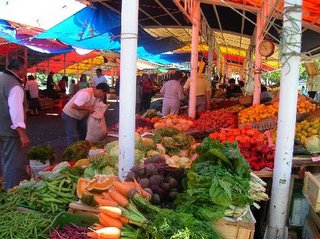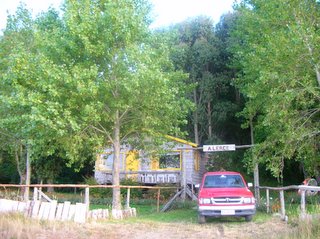Viña del Mar to Puerto Montt

Ben writes -
We took an early bus from Mendoza to Viña del Mar in Chile the next day. That meant that we had the journey over the Andes in glorious sunlight. It certainly was very memorable with fantastic snow capped vistas on both sides for many miles. The border crossing was painless although we had to eat all of our supply of bananas after we got busted by the officials. They don't like fruit being carried over borders apparantly. I didn't have one but apparantly they tasted very nice and officialdom was satisfied. Mum did not like some of the violent switchbacks on the mountain road into Chile - she thought the bus was going over the edge each corner. I had to take her mind of it by beating her at scrabble a few times.

It is fair to say that Viña was a little disapointing. We had just come from an amazing country where each place was as fantastic as the last and here we were in an overpriced hotel in a faded and grimy beach town with high rises and not much to recommend it. The first nigh we dined on chicken and chips in a local cafe which was a bit of a comedown from the fine dining we had been getting used to. It was OK but we offended the waiter by giving him a tiny tip - Chilean peso are worth almost nothing so everything costs thousands of them. We did not really understand the currency at that stage so his smile faded pretty fast unfortunately.
This is what Viña is supposed to look like.
The good thing about our hotel was that it was right outside a station on the excellent Viña/Valparaiso tube line so it was very easy to travel round the headland to neighbouring Valpo. Valpo is a very old historic port city which suffered much with the opening of the Panama canal but still retains many of its old grand buildings from the glory days along with plenty of amazing ramshackle houses that look like they are about to collapse down the steep cliffs any moment.
They also have anumber of ancient ascensors - funiculars which are fun but would not win any safety awards. Great veiws from the top though.

The same houses that appear in imminent danger of collapse are also often brightly painted which gives some of the barrios a cheerful air. Some of the walls are used for murals - there are obviosly some very talented artists in Valparaiso.

After we had looked aroud the town for a while and bought our bus tickets to Valdivia where we were going next Tigs and Mum went off to the supermarket to organise that night's dinner so Dad and me decided to wait for them in the nearest bar and have a couple of beers. Just over the road was a place called the 'Hamburg'. What a find.

There has been a lot of German immigration to Chile and as a result there is a lot of German influence on the food and drink in many parts of Chile. The Hamburg was an authentic German resturant and bar serving big stiens and massive germanic dinners.
The place was owned by a German sailor called Wolfgang who had spent twenty years filling the place with maritime memorabilia from the many ships that still pass through Valpo. The Chilean barstaff told us that stuff gets sent to the bar from all over the world. They had flags, ancors, lifebelts, caps, pictures and loads of other stuff in there. It was really like a museum. Brass plates from many ships covered the bar and we counted over 50 ship's bells which were kept constantly polished by the attentive staff. As well as this there were a few other interesting items on display including Pinochet's hat and cerimonial gavel. The portrait of Hitler and Afrika Korps flag must surely be a one off as well.
The staff were really freindly and could not do enough for us - especially when Tigs and Mum turned up and the chilean Senoras realised we were travelling as a family. Apparantly a number of Brits had been instrumental in Chilean independance from Spain. I had no idea about any of this but smiled and nodded as if I did. Lord Cochrane was the main guy so we were told. We were so impressed that we decided to come back again the next day for luch before we got our bus out. The lunch was great but very large. I had a massive boiled hock of pork on the knucle so it just fell off the bone on contact with my knife - fantastic.
We got the overnight bus via Santiago to Valdivia in the lake district several hundred kilometers to the south. We woke to find ourselves travelling past lake after lake in stunning countryside. After we had got settled in to a comfortable little place - the interestingly named 'Hostel Prat', we went out for a walk around Valdivia. Central to town life is the bustling vegetable and fish market right on the riverside.


The food was all wonderfully fresh and looked and smelt so good. We were also treated to a little caberet as a massive southern sealion pulled himself up onto the dockside and loudly demanded to be fed. We were told his name was 'Seawolf'. The fishmongers were happy to feed him as he pulled in the tourists and he was happy with all the fish. A real 'win win' situation.

Valdivia was lovely and had a really nice small town feel to it. We spent the rest of the day looking around town and then the next day we took a boattrip down the river to a couple of old Spanish forts where we enjoyed an enthusiastic reconstruction of their storming by the Chilean revolutionaries (Lord Cochrane again). The lads who performed it seemed to really enjoy kicking seven bells out of each other. The next day I stayed in bed as I was ill again and the others went to the Kuntsmann brewery. Valdivia is a German town and Kuntsmann brew the best beer in Chile (and South America if you ask me) from their brewery just out of town. We found out we had missed their annual bierfest by a couple of days which was a shame. The others enjoyed the brewery though while I ate dry crackers and watched cable TV.
Next day we got he bus to Puerto Montt 3 hours further south. The main reason people go there is get access to the great country that lies just south of there. We had decided to travel the Carretera Austral south into Chilean Pategonia but we would need our own transport as no decent buses run south from there. We decided to hire a truck.

And off we set. The road quickly ran out of tarmac and the weather took a turn for the worst. I had been banned from driving by 3 votes to 1 so Dad took on the driving duties to begin with. Soon we were really out in the back country. We arrived at the first of a series of ferry crossings where the road is unable to continue and water is the only option for onward travel. The scenery is menacing and powerful as well as beautiful. The road was poor - you certainly couldn't do this in a normal car. Even so, some people were trying to do just that.
We stopped for the night in the town of Hornopiren on the shores of an enormous fjord which we would need to get a ferry accross the next day. Packs of wild dogs roamed the streets and their howling kept Dad awake as we stayed in the amazing Hotel Hornopiren (below). It was made of wood but had open fires inside and scorch marks all the way up the outside from the flue. Inside was cosy but did not have one right angle in the whole building - very atmospheric. We liked it there.

The next day we awoke to find that the ferry from Hornopiren was full and there wouldn't be another one until 3am the next night - maybe. We decided to go back to Puerto Montt and out onto the island of Chiloe instead.
On the way back we stopped off at a couple of nice spots including the beautiful Rio Blanco.  We also tried to drive up to the entrance to Parque Nacional Hornopiren but the road was impassible. If we had gone on we would have probably got stranded.
We also tried to drive up to the entrance to Parque Nacional Hornopiren but the road was impassible. If we had gone on we would have probably got stranded.
We got another ferry over to Chiloe from south of Puerto Montt and found an idillic place to stay in the village of Caulin on the north coast of the island. We hired a cabaña by the beach which had many different types of birds and fantasticly fresh locally caught oysters served at the local resturant. At night the stars were brilliantly clear.




Chiloe is a very rural community which goes on much as it has done for hundreds of years uneffected by the outside world. Milk is still collected in churns and left by the side of the road for collection. Our time there was wonderful. For the next couple of days we drove around the island visiting the main town of Castro with it's stilted houses and a penquin colony at Isotes de Puñihuil.
and a penquin colony at Isotes de Puñihuil.

Then it was time to get the ferry back to Puerto Montt and have one last beer before saying goodbye to Mum and Dad and wishing them all the best for their journey home. What a great few weeks.

0 Comments:
Post a Comment
<< Home